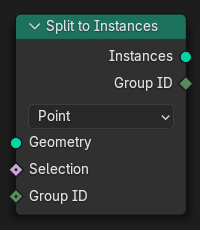Nút Tách Phân thành các Thực Thể [Split To Instances Node]¶

Splits a selection of geometry elements (such as faces) into groups, then turns each group into an instance.
Đầu Vào (Inputs)¶
- Hình Học (Geometry)
Đầu vào hình học tiêu chuẩn.
- Lựa Chọn (Selection)
Boolean field indicating which geometry elements to include.
- ID của Nhóm [Group ID]
Integer field indicating which group each element belongs to. Elements with the same ID will be moved into the same output instance.
Tính Chất (Properties)¶
- Phạm Vi (Domain)
The Thuộc Thể Loại Hình Học tới Trích Xuất và Tách Phân. This được đồng thời the Phạm Vi BẬT which the "Lựa Chọn" và "ID của Nhóm" trường sẽ được đã tính toán.
- Điểm (Point):
Điểm, mẫu cong điểm điều khiển, và điểm đỉnh.
- Edge (Cạnh):
Khung Lưới cạnh.
- Face (Mặt):
Khung Lưới mặt.
- Chốt Trục (Spline):
Đường Cong chốt trục.
- Thực Thể (Instance):
Tầng cao nhất thực thể. Realized thực thể sẽ được ignored.
- Tầng Lớp (Layer):
Bút Chì Dầu tầng lớp.
Ghi chú
Geometry that doesn't match the selected domain will be removed. For example, if you choose Edge, any faces, splines, and instances in the input geometry will be lost.
Đầu Ra (Output)¶
- Thực Thể (Instances)
The thực thể containing the theo nhóm hình học phần tử.
- ID của Nhóm [Group ID]
NhómD của mỗi một thực thể.
Một Số Ví Dụ (Examples)¶

In the example above, we start with a grid of 1000x1000 square faces serving as "pixels." Then, we group these faces into patches by assigning them a group ID sampled from a Voronoi texture, and move each resulting instance by a random amount along the Z axis.
Note that, because the texture outputs floating point values between 0 and 1 while the group ID is an integer, all the values would be rounded to 0 or 1 and we would only get two groups. To get more variation, we multiply the texture value by 1000.